Written by Peggy Morris, OTD, OTR/L, BCP . Peggy is an OT with 30+ years
pediatric experience in early intervention, private practice, and out-patient services – but most of her experience and passion is in school-based practice. She teaches graduate students in the occupational therapy department at Tufts University, and man, do they keep her on her toes! She practices yoga, garden, and play golf for mental health and wellness. She presents evidence-based courses via Apply EBP webinars. More information on these symposiums after the article below.
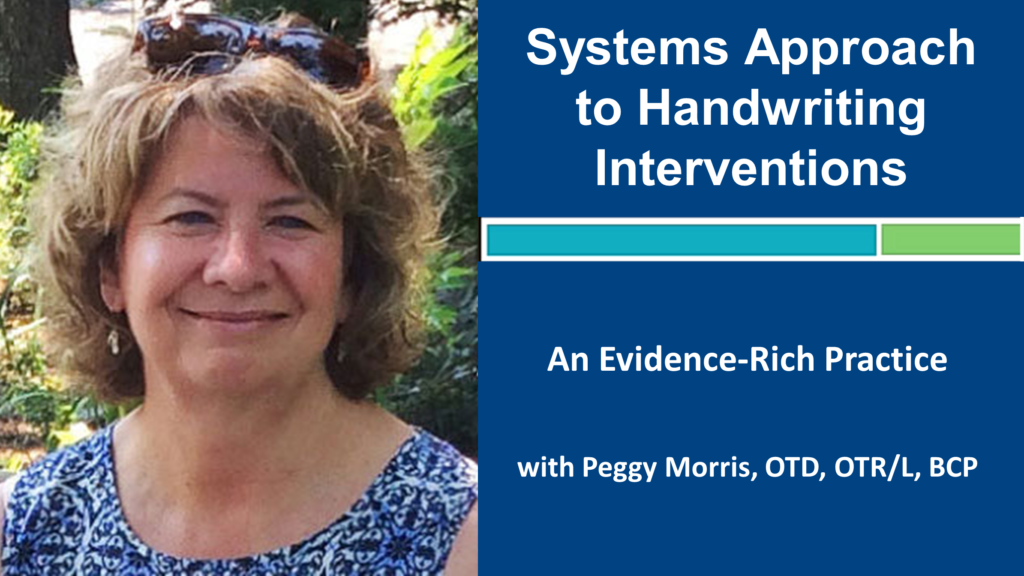
Systems Approach to Handwriting 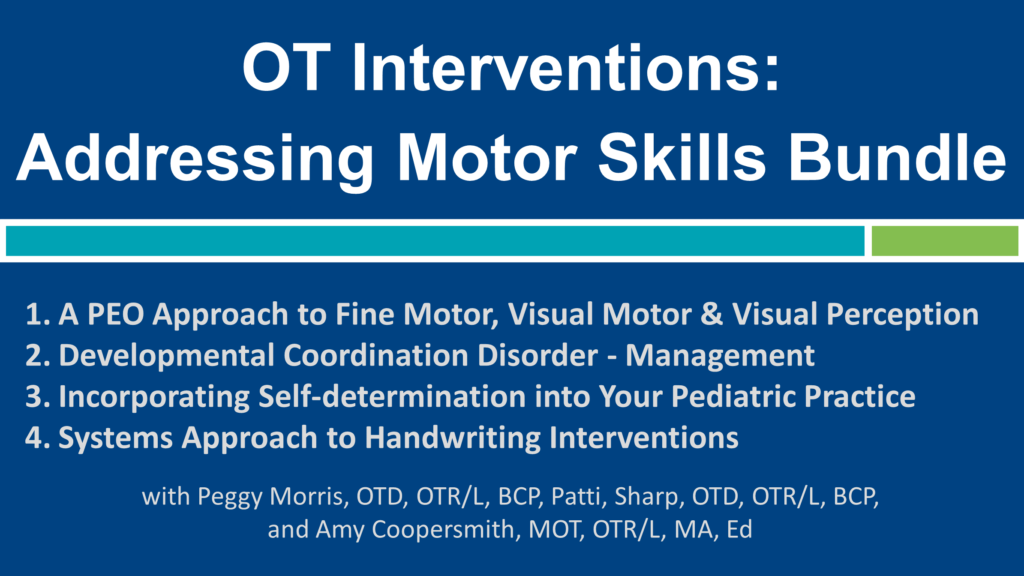
OT – Addressing Motor Skills 
Fine Motor, Visual Motor/Perception
[smbtoolbar]
Hello everyone! Welcome to OT month and our OT centennial celebration. Occupational Therapy is 100 years old this year (so is the National Hockey League, just sayin’).
Strengths-based Practice
I am excited to chat today with you about strengths in our students! Evaluating strengths (on purpose!), cultivating strengths, helping our students understand their unique strengths, and ultimately using strengths to accommodate for challenges.
What?! Bear with me as I share an example from my life, and I’ll do that through my executive function systems. So there are, depending on who you read, about eight characteristic executive functions: emotional control, shift, inhibition, monitor, organization of self, organization of materials, working memory, and initiation. Here is a link if you want definitions for each of these.
I would like you to think about these areas relative to yourself. Write down your strength from this list; mine is organization of materials. I am awesome at organizing things; I color-code, I make concept maps, I put things in bins, I label, etc.
Now, write down your challenge in this area; mine is working memory. I forget who I am talking to on the phone, I forget when my credit card payment is due, I don’t remember birthdays really well.
For sure, I have strategies on board to help with my challenges in working memory. So do you. Write down your strategies that are successful as you manage your challenge. One of my strategies is to make lists of the things I need to remember to do each day. I color-code that list: items in paler colors of markers are things that aren’t urgent and items in brighter color marker are Def-Con Level 1 items, things that need to be done like yesterday!
Guess what I realized? I use my strengths in organizing materials to accommodate for my challenges in working memory. Humans are amazing at adaptation. I am hopeful, that if you do not have a primarily strengths-based lens as a school-based therapist, that you might be open to thinking about this area.
~~~~~~~~~ 0 ~~~~~~~~~
The Why of a Strengths-based Practice
Authors (King, 2009; Wehmeyer, 2014) and professional organizations (AOTA, 2012) advocate promotion of strengths in evaluation and intervention with our students with disabilities as a way to address self-determination.
Self -determination is essentially the ability to control your own life; it has a theory built and evidence to support it as an important outcome for students with and without disabilities. In this lens, less emphasis is placed on ‘fixing’ the disability within the child or adolescent. More focus is placed on ‘fixing’ the disability within the environment or within the curriculum, along with facilitation of strengths-based strategies.
A strengths-based approach intentionally identifies strengths and resources within the client and uses these to enhance participation, much like my example above. This kind of focus is considered to be best practice by both AOTA (AOTA, 2014) and advanced practitioners in the field (Handley-More, Wall, Orentlicher, & Hollenbeck, 2013). And, of course, IDEA mandates we document student strengths on their IEP (IDEA, 2004).
~~~~~~~~~ 0 ~~~~~~~~~
The How-to of a Strengths-based Practice
So, how do we do it? Seems kinda simple, but it relies on a habit change, which is never that simple!
- First, do you buy it? Is this an idea that you could get behind enough to make a change in your practice habits?
- Second, what are some tools that identify strengths?
- Third, what are some intervention constructs and tools that might assist us to deliver a strengths-based intervention for our students?
Let’s pick these apart and start to talk about some answers.
~~~~~~~~~ 0 ~~~~~~~~~
1. Buy-in to a Strengths-based Approach
Buy-in is crucial; yours and the teachers and parents you work with. As a related service provider in school-based practice, we absolutely know how to evaluate and intervene for what the student can’t do. If we can add to this knowledge and skill set the ability to evaluate for strengths and interests, and capitalize on them in intervention, then we’ve added that strengths-based lens.
I’ve got a challenge for you: can we do this first? Before we evaluate the impacts of the disability? Think about how this might positively impact your students. They know what is difficult for them; they know their challenges, well, most of the time.
Cramm (2011) asks us to consider the messages we communicate to students as we work with them in therapy. The ‘fix-you’ approach implies something is broken with the student. Let’s say someone approached you once weekly, every Tuesday at 2:00 pm, with activities and tasks that you’re not very good at. These tasks are actually the epitome of difficulty for you! How would that make you feel about yourself? Probably not so good, right?
~~~~~~~~~ 0 ~~~~~~~~~
2. Use Strengths-based Evaluation Tools
So, here are 3 tools to get you thinking about how to evaluate strengths.
1. Canadian Occupational Performance Measure (COPM)
My first go-to is the COPM. It was designed for a client-centered approach and was developed as an outcome measure. So, two big thumbs-up for this tool!
- Cost:
- It’s not too expensive and can be either paper-based (~$50CAD) or app-based (~$10CAD + ~.15CAD per measure).
- Validity and Reliability:
- It’s been used in over 40 countries and is translated into more than 35 languages. It’s validity and reliability are well-established; it is one of the most researched OT assessment tools.
- Source:
- More info, including training videos, can be found at www.thecopm.ca.
- Using the COPM:
- You and your student, teacher, and/or parent work in a semi-structured interview format to determine how the student, teacher, and/or parent rates student performance in occupational performance areas, as well as how satisfied they are with that performance.
- When we ask our students to rate their own performance, prioritize areas for intervention, and then re-evaluate themselves, we set the stage for growth in important self-reflection, self-advocacy, and self-determination skills; strengths moving forward.
2. Child Occupational Self-Assessment (COSA)
Another tool I’m fond of is the COSA. It is also a tool designed for client-centered care and as an outcome tool. Yahoo!
- Cost:
- It’s inexpensive ($40USD) and available in three different formats (text, symbols, and a card sort).
- Source:
- It is available from the Model of Human Performance (MOHO) website at the University of Illinois; http://www.cade.uic.edu/moho/.
- Using the COSA:
- The COSA allows our students to express their own opinions regarding strengths as well as areas needing improvement.
2. StrengthsExplorer
I’ve recently evaluated my own strengths as a professional development tool for my future planning. I ended up using the online tool Clifton StrengthsFinder; www.strengthsfinder.com, after researching a few online tools that were free, as I felt its results were an accurate depiction of my strengths.
- Cost:
- Ranges from $15USD to $89USD depending on level of response you pick.
- Source:
- It is available through https://www.gallupstrengthscenter.com
- Using StrengthFinder:
- There is a youth version, StrengthsExplorer, for ages 10-14, that discusses strengths as talents. I haven’t used the youth one in practice, as I just became aware of it. My suggestion would be if you are interested in the StrengthsExplorer, perhaps evaluate yourself with the Strengthsfinder first, so you have an understanding of the process and how the results are presented to you.
~~~~~~~~~ 0 ~~~~~~~~~
3. Apply Strengths-based Interventions
Now on to how to apply the strengths-based approach to our interventions with students. Three ideas here for you to think about and research further.
1. Rethink Our Words
The first is the concept of rethinking our disability/deficit terminology. I usually head folks to a 2015 TEDxTalk by Dr. Lisa Thornton, a pediatric rehabilitation physician who eloquently speaks of “re-languaging” for parents and educational professionals.
Can we switch suffers from mental health issues to working with mental health challenges? Can we switch learning disability to learns differently? Words matter.
2. Positive Self-Talk
The next idea is grounded in the tenets of positive psychology (Seligman & Csikszentmihalyi, 2000). Fortunately, the research tells us that if we think in terms of positive self-worth, employ positive self-talk, and use our strengths, then we benefit from positive impacts to self-esteem, self-identity, disability identity, and ultimately self-determination (Govindji & Linley, 2007).
Let’s start with positive self-talk. I’m great! I’m awesome! I can do math! I can make friends easily! More words that matter.
3. Focus on What’s Working
The third is the manner in which we ask our questions. Rather than ask “What’s not working?” let’s start instead with asking our students, parents, and teachers “What’s working?”
When we intentionally ask about what is going well, we head the conversation in an entirely different direction impacting positive feelings for self, and believe it or not, through the lens of appreciative inquiry (Cooperrider, Whitney, & Stavros, 2008), we can set in motion change in the positive direction. Wow!
4. Occupational Performance Coaching
I actually have a fourth idea, occupational performance coaching as a method of intervention that is student-centered and strengths-based. Hmmm. There’s research on it that I’d love to share. Perhaps next time!
Join Peggy and other evidence-based presenter at these webinars
References:
American Occupational Therapy Association. (2014). Occupational therapy practice framework: Domain and process (3rd ed.) American Journal of Occupational Therapy, 68, S1-S48.
American Occupational Therapy Association (2012). Occupational Therapy’s Role in Promoting Strengths in children and youth. Retrieved from http:// www.aota.org/Practitioners-Section/Children-and-Youth/Browse/School/Mental-Health/Toolkit.aspx
Cooperrider, D., Whitney, D.D., & Starvos, J.M. (2008) the apprecioative inquiry handbook: For leaders of change. Brunswick, OH, Crown Custom Publishing.
Cramm, H. (2011). Can interventions have a negative impact? The importance of seeing the biger picture. Physical and Occupational Therapy in Pediatrics, 31, 217-221.
Govindji, R. Linley, P.A. (2007). Strengths use, self-concordance, and well-being: Implications for strengths coaching and coaching psychologists. International Coaching Psychology Review, 2(2), 143-153.
Handley-More, D. Wall, E., Orentilicher, M.L., & Hollenbeck, J. (2013, March). Working in early intervention and school settings: Current views of best practice. Early Intervention and School Special Interest Section Quarterly, 20(2), 1-4.
Individuals with Disabilities Education Improvement Act of 2004, Pub.L. 108-446, 20 U.S.C. 1400-1482.
King, G. (2009). A relational goal-oriented model of optimal service delivery to children and families. Physical and Occupational Therapy in Pediatrics, 29, 384-408.
Seligman, M.E.P., & Csikszentmihalyi, M. (2000). Positive psychology: An introduction. American Psychologist, 55, 4-14.
Wehmeyer, M. (2014). Framing the future: Self-determination. Remedial and Special Education, 36(1), 20-23.
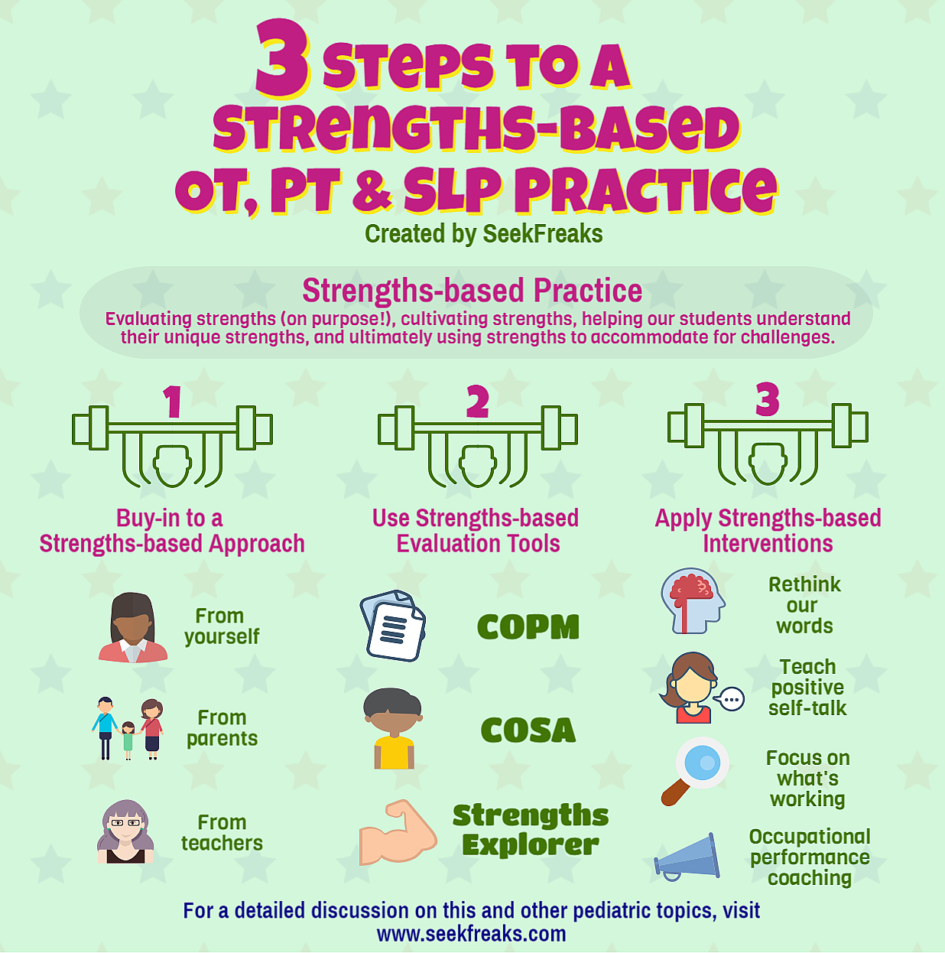

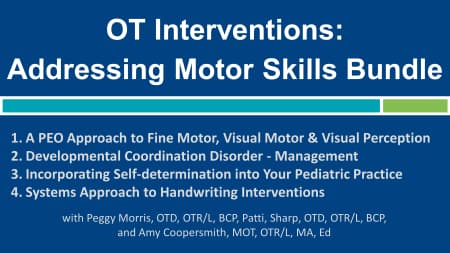
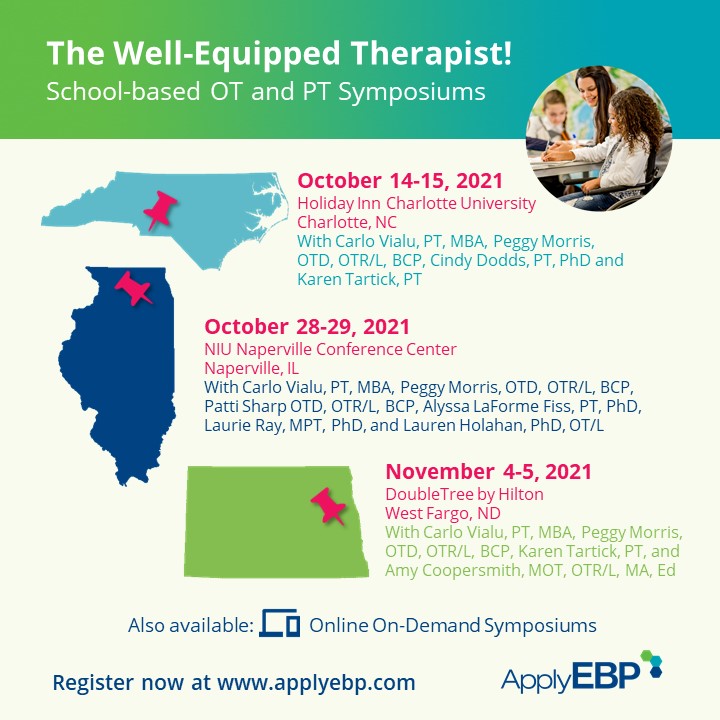
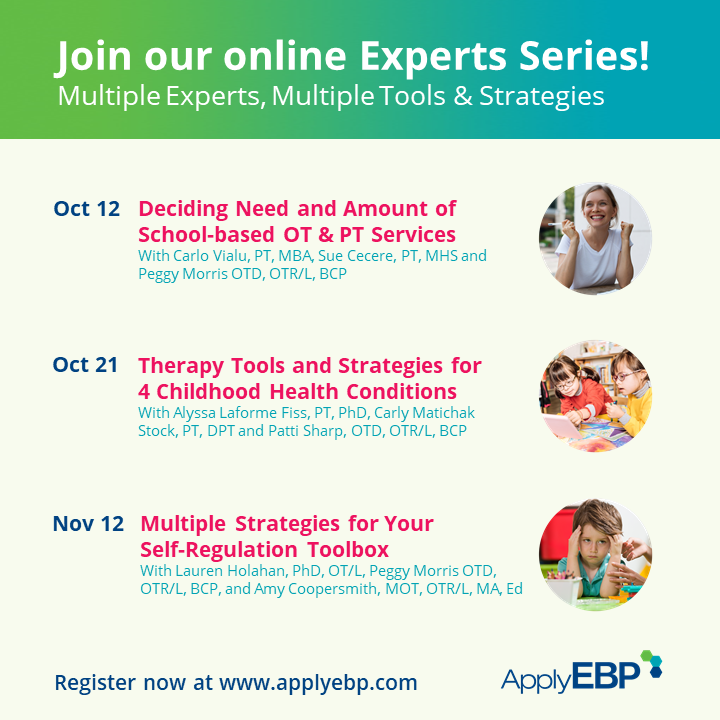











August 2, 2019 at 3:02 pm
I have noticed you don’t monetize seekfreaks.com, don’t
waste your traffic, you can earn additional bucks every month with new monetization method.
This is the best adsense alternative for
any type of website (they approve all sites), for more details simply search in gooogle:
murgrabia’s tools